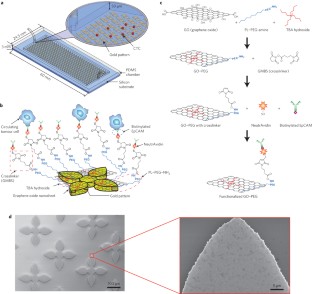2024-01-29 ミシガン大学
◆CTスキャンでは大きな変化しかわからないが、このチップはがん細胞を血液中で追跡し、治療の即効性を提供します。流動生検では頻繁に情報を得ることができず、血液検査がその代替となっています。特に肺がんでは従来の方法が効果的でないことから、このチップは液体生検の手法を進化させ、効果的ながん治療をサポートします。
<関連情報>
- https://news.umich.edu/is-lung-cancer-treatment-working-this-chip-can-tell-from-a-blood-draw/
- https://www.cell.com/cell-reports/fulltext/S2211-1247(24)00015-9
- https://www.nature.com/articles/nnano.2013.194
化学放射線療法と免疫療法を受けているステージIIIのNSCLC患者において、循環腫瘍細胞が病勢進行の早期予測因子を明らかにする Circulating tumor cells reveal early predictors of disease progression in patients with stage III NSCLC undergoing chemoradiation and immunotherapy
Emma Purcell,Zeqi Niu,Sarah Owen,… Theodore Lawrence,Shruti Jolly,Sunitha Nagrath
Cell Reports Published:January 22, 2024
DOI:https://doi.org/10.1016/j.celrep.2024.113687
Highlights
•A larger decrease in CTCs during chemoradiation predicted longer PFS
•Tumor cells in circulation become more aggressive phenotypically during chemoradiation
•High PD-L1+ CTC percentage predicted shorter PFS in durvalumab patients
Summary
Circulating tumor cells (CTCs) are early signs of metastasis and can be used to monitor disease progression well before radiological detection by imaging. Using an ultrasensitive graphene oxide microfluidic chip nanotechnology built with graphene oxide sheets, we were able to demonstrate that CTCs can be specifically isolated and molecularly characterized to predict future progression in patients with stage III non-small cell lung cancer (NSCLC). We analyzed CTCs from 26 patients at six time points throughout the treatment course of chemoradiation followed by immune checkpoint inhibitor immunotherapy. We observed that CTCs decreased significantly during treatment, where a larger decrease in CTCs predicted a significantly longer progression-free survival time. Durvalumab-treated patients who have future progression were observed to have sustained higher programmed death ligand 1+ CTCs compared to stable patients. Gene expression profiling revealed phenotypically aggressive CTCs during chemoradiation. By using emerging innovative bioengineering approaches, we successfully show that CTCs are potential biomarkers to monitor and predict patient outcomes in patients with stage III NSCLC.
Graphical abstract

機能化酸化グラフェンナノシートによる循環腫瘍細胞の高感度捕捉 Sensitive capture of circulating tumour cells by functionalized graphene oxide nanosheets
Hyeun Joong Yoon,Tae Hyun Kim,Zhuo Zhang,Ebrahim Azizi,Trinh M. Pham,Costanza Paoletti,Jules Lin,Nithya Ramnath,Max S. Wicha,Daniel F. Hayes,Diane M. Simeone & Sunitha Nagrath
Nature Nanotechnology Published:29 September 2013
DOI:https://doi.org/10.1038/nnano.2013.194

Abstract
The spread of cancer throughout the body is driven by circulating tumour cells (CTCs)1. These cells detach from the primary tumour and move from the bloodstream to a new site of subsequent tumour growth. They also carry information about the primary tumour and have the potential to be valuable biomarkers for disease diagnosis and progression, and for the molecular characterization of certain biological properties of the tumour. However, the limited sensitivity and specificity of current methods for measuring and studying these cells in patient blood samples prevents the realization of their full clinical potential. The use of microfluidic devices is a promising method for isolating CTCs2,3. However, the devices are reliant on three-dimensional structures, which limits further characterization and expansion of cells on the chip. Here we demonstrate an effective approach to isolating CTCs from blood samples of pancreatic, breast and lung cancer patients, by using functionalized graphene oxide nanosheets on a patterned gold surface. CTCs were captured with high sensitivity at a low concentration of target cells (73 ± 32.4% at 3–5 cells per ml blood).


